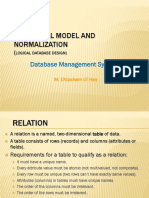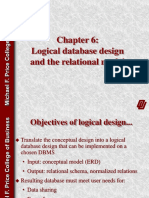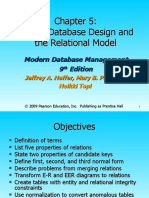LEC 04 Logical Database Design and Relational Database
Uploaded by
Kate RamirezLEC 04 Logical Database Design and Relational Database
Uploaded by
Kate Ramirez2/16/2012
Relation
3
A relation is a named, two-dimensional table of data. A table consists of rows (records) and columns (attribute or field).
LOGICAL DATABASE DESIGN AND RELATIONAL DATABASE
Relation
4 6
Key Fields
Requirements for a table to qualify as a relation:
Keys are special fields that serve two main purposes:
It must have a unique name. Every attribute value must be simple. Every row must be unique. Attributes in tables must have unique names. The order of the columns must be irrelevant. The order of the rows must be irrelevant.
Primary keys are unique identifiers of the rows in the relation. This is how we can guarantee that all rows are unique. Foreign keys are identifiers that enable a dependent relation to refer to its parent relation.
Keys can be simple (a single field) or composite (more than one field). Keys usually are used as indexes to speed up the response to user queries.
2/16/2012
Figure 4-3 Schema for four relations (Furniture Company)
8
Integrity Constraints
Constraints or rules limiting acceptable values and actions, whose purpose is to facilitate maintaining the accuracy and integrity of data in the database. Domain Constraints
Allowable values for an attribute. Domain: set of values that may be assigned to an attribute No primary key attribute may be null. All primary key fields MUST have data
Entity Integrity
Integrity Constraints
10
Referential Integrity States that any foreign key value (on the relation of the many side) MUST match a primary key value in the relation of the one side. (Or the foreign key can be null) For example: Delete Rules
Domain definitions enforce domain integrity constraints
9
Cascadeautomatically delete dependent side rows that correspond with the parent side row to be deleted Restrictdont allow delete of parent side if related rows exist in dependent side Set-to-Nullset the foreign key in the dependent side to null if deleting from the parent side is not allowed for weak entities
2/16/2012
Figure 4-5 Referential integrity constraints (Furniture shop)
Figure 4-6 SQL table definitions
Referential integrity constraints are drawn via arrows from dependent to parent table
Referential integrity constraints are implemented with foreign key to primary key references
11
12
Mapping Regular Entities to Relations
13
Figure 4-8 Mapping a regular entity (a) CUSTOMER entity type with simple attributes
Simple attributes: E-R attributes map directly onto the relation Composite attributes: Use only their simple, component attributes Multi-valued attributes: Becomes a separate relation with a foreign key taken from the superior entity
(b) CUSTOMER relation
14
2/16/2012
Figure 4-9 Mapping a composite attribute
(a) CUSTOMER entity type with composite attribute
Figure 4-10 Mapping an entity with a multivalued attribute (a)
Multivalued attribute becomes a separate relation with foreign key
(b) CUSTOMER relation with address detail
(b)
15
16
Mapping Weak Entities
17
Figure 4-11 Example of mapping a weak entity a) Weak entity DEPENDENT
Becomes a separate relation with a foreign key taken from the superior entity Primary key composed of:
Partial identifier of weak entity Primary key of identifying relation (strong entity)
18
2/16/2012
Figure 4-11 Example of mapping a weak entity (cont.) b) Relations resulting from weak entity
20
Mapping Binary Relationships
NOTE: the domain constraint for the foreign key should NOT allow null value if DEPENDENT is a weak entity Foreign key
One-to-Many: Primary key on the one side becomes a foreign key on the many side Many-to-Many: Create a new relation with the primary keys of the two entities as its primary key One-to-One: Primary key on the mandatory side becomes a foreign key on the optional side
Composite primary key
19
Figure 4-12 Example of mapping a 1:M relationship a) Relationship between customers and orders
Figure 4-13 Example of mapping an M:N relationship a) Completes relationship (M:N)
Note the mandatory one
b) Mapping the relationship
The Completes relationship will need to become a separate relation
Foreign key
21 22
2/16/2012
Figure 4-13 Example of mapping an M:N relationship (cont.) b) Three resulting relations
Figure 4-14 Example of mapping a binary 1:1 relationship a) In charge relationship (1:1)
Composite primary key
Foreign key Foreign key
New intersection relation Often in 1:1 relationships, one direction is optional
23
24
Figure 4-14 Example of mapping a binary 1:1 relationship (cont.) b) Resulting relations
26
Mapping Associative Entities
Identifier Not Assigned
Default primary key for the association relation is composed of the primary keys of the two entities (same as M:N relationship) It is natural and familiar to end-users Default identifier may not be unique
Identifier Assigned
Foreign key goes in the relation on the optional side, matching the primary key on the mandatory side
25
2/16/2012
Figure 4-15 Example of mapping an associative entity a) An associative entity
Figure 4-15 Example of mapping an associative entity (cont.) b) Three resulting relations
Composite primary key formed from the two foreign keys
27 28
Figure 4-16 Example of mapping an associative entity with an identifier a) SHIPMENT associative entity
Figure 4-16 Example of mapping an associative entity with an identifier (cont.) b) Three resulting relations
Primary key differs from foreign keys
29
30
2/16/2012
Mapping Unary Relationships
31
Figure 4-17 Mapping a unary 1:N relationship
One-to-Many: Recursive foreign key in the same relation Many-to-Many: Two relations: One for the entity type One for an associative relation in which the primary key has two attributes, both taken from the primary key of the entity
(a) EMPLOYEE entity with unary relationship
(b) EMPLOYEE relation with recursive foreign key
32
Figure 4-18 Mapping a unary M:N relationship
Mapping Ternary (and n-ary) Relationships
(a) Bill-of-materials relationships (M:N)
34
One relation for each entity and one for the associative entity Associative entity has foreign keys to each entity in the relationship
(b) ITEM and COMPONENT relations
33
2/16/2012
Figure 4-19 Mapping a ternary relationship a) PATIENT TREATMENT Ternary relationship with associative entity Figure 4-19 Mapping a ternary relationship (cont.) b) Mapping the ternary relationship PATIENT TREATMENT
NOTE: Remember that the primary key MUST be unique
35
36
Data Normalization
37 38
Well-Structured Relations
Primarily a tool to validate and improve a logical design so that it satisfies certain constraints that avoid unnecessary duplication of data Goal: decompose relations with anomalies to produce smaller, well-structured relations Anomaly: an error or inconsistency that may result when a user attempts to update a table that contains redundant data.
A relation that contains minimal data redundancy and allows users to insert, delete, and update rows without causing data inconsistencies Goal is to avoid anomalies Insertion Anomaly: adding new rows forces user to create duplicate data Deletion Anomaly: deleting rows may cause a loss of data that would be needed for other future rows Modification Anomaly: changing data in a row forces changes to other rows because of duplication
General rule of thumb: A table should not pertain to more than one entity type
2/16/2012
Anomalies in this Table
40
Insertioncant enter a new employee without having the employee take a class Deletionif we remove employee 140, we lose information about the existence of a Tax Acc class Modificationgiving a salary increase to employee 100 forces us to update multiple records
Why do these anomalies exist? Because there are two themes (entity types) in this one relation. This results in data duplication and an unnecessary dependency between the entities
QuestionIs this a relation? QuestionWhats the primary key?
AnswerYes: Unique rows and no multi-valued attributes AnswerComposite: EmpID, CourseTitle
Functional Dependencies and Keys
41
Steps in normalization
Functional Dependency: The value of one attribute (the determinant) determines the value of another attribute Candidate Key: A unique identifier. One of the
candidate keys will become the primary key
E.g. perhaps there is both credit card number and SS# in a tablein this case both are candidate keys
Each non-key field is functionally dependent on every candidate key
3rd normal form is generally considered sufficient
42
10
2/16/2012
First Normal Form
43
No multi-valued attributes Every attribute value is atomic All relations are in 1st Normal Form
Insertion: if new product is ordered for order 1007 of existing customer, customer data must be re-entered, causing duplication Deletion: if we delete the Dining Table from Order 1006, we lose information concerning this item's finish and price Update: changing the price of product ID 4 requires update in multiple records
45
Second Normal Form
47
Functional dependency diagram for INVOICE
1NF PLUS no partial functional dependencies
Partial functional dependency: exists when a non-key attribute is functionally dependent on part of the primary key Every non-key attribute must be defined by the entire key, not by only part of the key
OrderID: OrderDate, CustomerID, CustomerName, CustomerAddress ProductID: ProductDescription, ProductFinish, ProductStandardPrice OrderID, ProductID: OrderQuantity
11
2/16/2012
Third Normal Form
Removing partial dependencies
50
Partial dependencies are removed, but there are still transitive dependencies
49
2NF PLUS no transitive dependencies (functional dependency between the primary key and one or more non-key attributes) Note: This is called transitive, because the primary key is a determinant for another attribute, which in turn is a determinant for a third Solution: Non-key determinant with transitive dependencies go into a new table; non-key determinant becomes primary key in the new table and stays as foreign key in the old table
Removing partial dependencies
Transitive dependencies are removed
12
You might also like
- The Handbook of Japanese Linguistics (PDFDrive)100% (1)The Handbook of Japanese Linguistics (PDFDrive)1,063 pages
- Specification For Aluminum Brazing - American Welding SocietNo ratings yetSpecification For Aluminum Brazing - American Welding Societ28 pages
- Logical Database Design and The Relational ModelNo ratings yetLogical Database Design and The Relational Model50 pages
- Advance Database Systems: Overview of Data ModelingNo ratings yetAdvance Database Systems: Overview of Data Modeling33 pages
- Relational Model and Data NormalizationNo ratings yetRelational Model and Data Normalization48 pages
- Chapter-4 Logical Database Design: ObjectivesNo ratings yetChapter-4 Logical Database Design: Objectives20 pages
- 05 - HO - Logical Database Design and The Relational Model100% (1)05 - HO - Logical Database Design and The Relational Model14 pages
- Logical Database Design and The Relational ModelNo ratings yetLogical Database Design and The Relational Model109 pages
- Chapter 4 Part 1 (A) : Logical Database Design and The Relational ModelNo ratings yetChapter 4 Part 1 (A) : Logical Database Design and The Relational Model48 pages
- Mapping Logical Data Model To Relational Schema (Physical Data Model)No ratings yetMapping Logical Data Model To Relational Schema (Physical Data Model)31 pages
- Logical Database Design and The Relational Model: Peter KaayaNo ratings yetLogical Database Design and The Relational Model: Peter Kaaya26 pages
- Logical Database Design and The Relational ModelNo ratings yetLogical Database Design and The Relational Model52 pages
- Logical Database Design and The Relational ModelNo ratings yetLogical Database Design and The Relational Model52 pages
- Unit-2 Relational Model & Normalization(1NF 2NF 3NF BCNF)No ratings yetUnit-2 Relational Model & Normalization(1NF 2NF 3NF BCNF)42 pages
- Logical Database Design and The Relational ModelNo ratings yetLogical Database Design and The Relational Model57 pages
- Chapter 4 Logical Database Design and The Relational Model PartNo ratings yetChapter 4 Logical Database Design and The Relational Model Part17 pages
- Relational Database Design - : Mapping ERD To RelationalNo ratings yetRelational Database Design - : Mapping ERD To Relational61 pages
- Physical Database Design Lecture SlidesNo ratings yetPhysical Database Design Lecture Slides113 pages
- Logical Database Design and The Relational Model: (Part 1)No ratings yetLogical Database Design and The Relational Model: (Part 1)21 pages
- Detailed Explanations Logical Phase PartNo ratings yetDetailed Explanations Logical Phase Part6 pages
- Translation of ER-diagram Into Relational SchemaNo ratings yetTranslation of ER-diagram Into Relational Schema64 pages
- Applying ER artifacts to different business use casesNo ratings yetApplying ER artifacts to different business use cases24 pages
- Data Management and Database Design: INFO 6210 Week #4No ratings yetData Management and Database Design: INFO 6210 Week #444 pages
- Chapter02-02 Database Design - Transforming ERD Into RelationNo ratings yetChapter02-02 Database Design - Transforming ERD Into Relation42 pages
- IS202 Data Management: Part 2: NormalizationNo ratings yetIS202 Data Management: Part 2: Normalization39 pages
- Introductory Relational Database Design for Business, with Microsoft AccessFrom EverandIntroductory Relational Database Design for Business, with Microsoft AccessNo ratings yet
- Digital Filters - Implementation and Design: Basic Filtering OperationsNo ratings yetDigital Filters - Implementation and Design: Basic Filtering Operations19 pages
- New Functionality Added To Isismarc (Isismarc 1.542) : I. Search Records Inside IsismarcNo ratings yetNew Functionality Added To Isismarc (Isismarc 1.542) : I. Search Records Inside Isismarc37 pages
- Karmila Kristina Paladang, Siane Indriani, Kurnia P. S DirgantoroNo ratings yetKarmila Kristina Paladang, Siane Indriani, Kurnia P. S Dirgantoro11 pages
- Nanocap: Nanotechnology: A Brief IntroductionNo ratings yetNanocap: Nanotechnology: A Brief Introduction11 pages
- Annotated Bibliography (Week 2-4) .EditedNo ratings yetAnnotated Bibliography (Week 2-4) .Edited5 pages
- Management Control and Management Control Systems: General InformationNo ratings yetManagement Control and Management Control Systems: General Information3 pages
- Sumada 2018 J. Phys. Conf. Ser. 953 012214No ratings yetSumada 2018 J. Phys. Conf. Ser. 953 0122146 pages
- NAPLAN Reading Year 7 2008 Quick Answers: and GlassNo ratings yetNAPLAN Reading Year 7 2008 Quick Answers: and Glass1 page
- Beige Blue Red Modern English Oral Communication Interpersonal Communicatio 20240125 212113 0000No ratings yetBeige Blue Red Modern English Oral Communication Interpersonal Communicatio 20240125 212113 000013 pages
- KTU S5 Microprocessor and Microcontroller CSE May 2019 Question Paper0% (1)KTU S5 Microprocessor and Microcontroller CSE May 2019 Question Paper2 pages
- LK 2 - Modul 4 - Ade Permata Sari - Bahasa InggrisNo ratings yetLK 2 - Modul 4 - Ade Permata Sari - Bahasa Inggris3 pages
- Strong Duality Results: September 22, 2008No ratings yetStrong Duality Results: September 22, 200817 pages
- The Fagan Test of Infant Intelligence: ManualNo ratings yetThe Fagan Test of Infant Intelligence: Manual58 pages
- Conflict and Negotiation: Organizational BehaviorNo ratings yetConflict and Negotiation: Organizational Behavior24 pages
- Customer Value Management Concepts and Case Study: Sunil Thawani Adnoc DistributionNo ratings yetCustomer Value Management Concepts and Case Study: Sunil Thawani Adnoc Distribution38 pages
- Strategic Intervention Material IN Mathematics Iv100% (1)Strategic Intervention Material IN Mathematics Iv23 pages
- The Evolution of Recent Developments in Formal Language Theory From The 1960's.No ratings yetThe Evolution of Recent Developments in Formal Language Theory From The 1960's.2 pages
- Specification For Aluminum Brazing - American Welding SocietSpecification For Aluminum Brazing - American Welding Societ
- Advance Database Systems: Overview of Data ModelingAdvance Database Systems: Overview of Data Modeling
- 05 - HO - Logical Database Design and The Relational Model05 - HO - Logical Database Design and The Relational Model
- Chapter 4 Part 1 (A) : Logical Database Design and The Relational ModelChapter 4 Part 1 (A) : Logical Database Design and The Relational Model
- Mapping Logical Data Model To Relational Schema (Physical Data Model)Mapping Logical Data Model To Relational Schema (Physical Data Model)
- Logical Database Design and The Relational Model: Peter KaayaLogical Database Design and The Relational Model: Peter Kaaya
- Unit-2 Relational Model & Normalization(1NF 2NF 3NF BCNF)Unit-2 Relational Model & Normalization(1NF 2NF 3NF BCNF)
- Chapter 4 Logical Database Design and The Relational Model PartChapter 4 Logical Database Design and The Relational Model Part
- Relational Database Design - : Mapping ERD To RelationalRelational Database Design - : Mapping ERD To Relational
- Logical Database Design and The Relational Model: (Part 1)Logical Database Design and The Relational Model: (Part 1)
- Applying ER artifacts to different business use casesApplying ER artifacts to different business use cases
- Data Management and Database Design: INFO 6210 Week #4Data Management and Database Design: INFO 6210 Week #4
- Chapter02-02 Database Design - Transforming ERD Into RelationChapter02-02 Database Design - Transforming ERD Into Relation
- Introductory Relational Database Design for Business, with Microsoft AccessFrom EverandIntroductory Relational Database Design for Business, with Microsoft Access
- Digital Filters - Implementation and Design: Basic Filtering OperationsDigital Filters - Implementation and Design: Basic Filtering Operations
- New Functionality Added To Isismarc (Isismarc 1.542) : I. Search Records Inside IsismarcNew Functionality Added To Isismarc (Isismarc 1.542) : I. Search Records Inside Isismarc
- Karmila Kristina Paladang, Siane Indriani, Kurnia P. S DirgantoroKarmila Kristina Paladang, Siane Indriani, Kurnia P. S Dirgantoro
- Management Control and Management Control Systems: General InformationManagement Control and Management Control Systems: General Information
- NAPLAN Reading Year 7 2008 Quick Answers: and GlassNAPLAN Reading Year 7 2008 Quick Answers: and Glass
- Beige Blue Red Modern English Oral Communication Interpersonal Communicatio 20240125 212113 0000Beige Blue Red Modern English Oral Communication Interpersonal Communicatio 20240125 212113 0000
- KTU S5 Microprocessor and Microcontroller CSE May 2019 Question PaperKTU S5 Microprocessor and Microcontroller CSE May 2019 Question Paper
- LK 2 - Modul 4 - Ade Permata Sari - Bahasa InggrisLK 2 - Modul 4 - Ade Permata Sari - Bahasa Inggris
- Customer Value Management Concepts and Case Study: Sunil Thawani Adnoc DistributionCustomer Value Management Concepts and Case Study: Sunil Thawani Adnoc Distribution
- The Evolution of Recent Developments in Formal Language Theory From The 1960's.The Evolution of Recent Developments in Formal Language Theory From The 1960's.

























































































